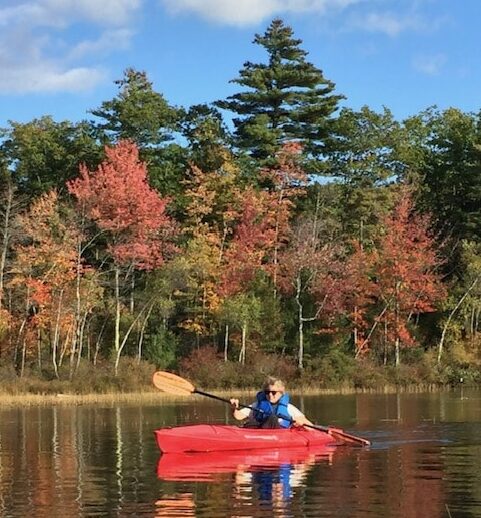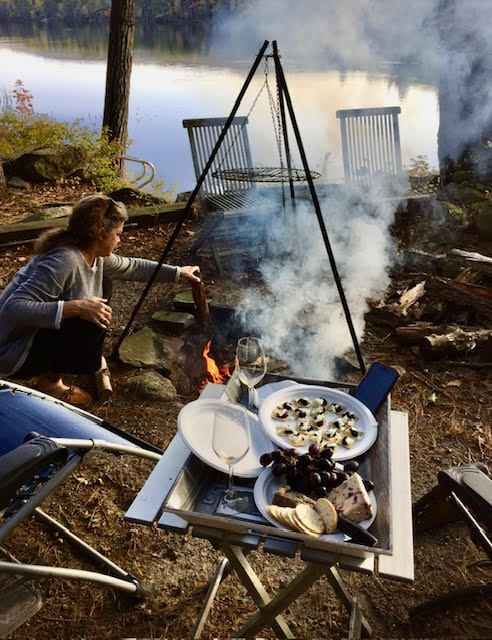With warm clothes and bedding and a cozy fire, fall camping can be even better than in summer.
Fall camping? Just get up and go.
Fall may be the best time for camping, free of mosquitoes, no-see-ums, and biting flies. The warmth of a fire is a joy instead of something to be endured on hot summer nights. Crisp air, aromatic with forest bracken, low humidity, and leaves burnished red and gold will make memorable days. The lack of tourist crowds makes it more likely you’ll see wildlife on quiet summer evenings.
When I was growing up, my family’s vacations followed a New York City school calendar because my parents both worked in the field of education. The long golden summer didn’t end with Labor Day. We camped all summer and after school resumed we headed back “upstate” on long holiday weekends. Even my Girl Scout Troop went on fall camping excursions out of the city, tenting among blowing leaves, sitting cross-legged on the damp ground on our homemade “sit-upons,” and cooking over tiny stoves we’d made out of coffee cans.
I’ve been eating at picnic tables ever since I can remember. To cook for their family of five my parents had an astonishing assortment of gear that included an unbreakable metal mirror, accordion water jug, collapsible canvas sink, and even an ingenious folding reflecting oven.


My dad’s fishing gear was put to good use, and we breakfasted on fresh trout rolled in cornmeal and fried in bacon fat. Sliced bread was browned one side at a time on a portable “toaster” that sat over the heat of an open flame. In summer we stopped at farm stands for fresh corn and dropped coins into “honor system” boxes at the side of the road for self-serve tomatoes, carrots, and salad greens, bread-and-butter pickles and homemade preserves. Pretending to be pioneers, we kids foraged for tiny wild strawberries, fat tart blackberries, and crayfish hiding in the shady shallows of the brooks. When we had enough blueberries at one time, my mother or my dad — they were both good cooks — might be persuaded to make a pie or cobbler.
In the fall the pie was likely to be brought from home, but our huge cast-iron Dutch oven would be used for my dad’s cold-weather recipes – improvised chili, stews, or a muddle of beef and tomato and noodles my dad called “slumgullion.”
When my own kids were small, my husband and I took them camping in New Hampshire, Maine, Vermont, and New York. Some things had changed, but a surprising number had stayed the same, not the least of which was the pleasure of eating at an oilcloth-covered table as a campfire crackled nearby and the fragrance of its smoke mingled with the aromas of dinner.
Everything tastes better when cooked over a wood fire, and the challenge of having limited kitchen supplies can be strangely freeing.
Fall camping menu
Just because you’re camping doesn’t mean you can’t eat as well as — or even better than — you do at home. Everything tastes better when cooked over a wood fire, and the challenge of having limited kitchen supplies can be strangely freeing.
For your camp kitchen you will need basic supplies: oil, flour, sugar, salt and pepper. For fall camping, bring a bag of onions and one of potatoes, and a cooler or two for perishable foods. Be sure to bring a supply of large resealable bags for holding everything from marinating meats to cutlery to loose paper napkins. And don’t forget a cutting board and at least one large sharp knife.
My husband’s and kids’ all-time favorite camping meal is one that was absurdly fussy, consisting of finely diced fresh salmon mixed with mashed avocado, sour cream, chipotle puree, and chopped cilantro, piled on thin slices of plantain fried in a big skillet on the camp stove.
But some of the finest camp meals require minimal effort, time and — perhaps best of all — cleanup. A piquant salad dressing made with lemon juice, oil, and garlic can easily be stored in a cooler for a week without spoiling, and tossed with fresh greens or on sliced tomatoes is a nice accompaniment to grilled meat, fish, or pasta. Fish (which should be kept well-chilled and eaten as soon as possible) can be marinated in a sealed container or plastic bag, transferred directly onto a hot grill, and perfectly cooked in a matter of minutes.
To upgrade burgers, make them out of ground lamb mixed with minced onion. Grill and serve on brioche buns with Greek tzatziki (cucumber yogurt) sauce, both available in most supermarkets.
If you’ll have friends dropping by your campsite in time for an evening dinner, impress them with a “spatchcocked” chicken slowly roasted while you baste it with bacon fat and beer. As its juices drip and sizzle in the fire, you can sit back and relax, and know that under the stars there’s no better place to be.

Camping and cooking gear
Cookware and utensils
Don’t even think about bringing your stainless steel or nonstick pans on a camping trip, unless they are one step away from going into the recycling bin. Camping requires heavy-duty cookware that can bear the heat of a very hot fire, that won’t suffer from blackening by open flames, that have heatproof…no, fire-proof, handles, and that by retaining heat, will make the most of the flame from a portable stove. The only cookware that can do all of this is cast-iron, and if it’s cared for properly it can be used for many generations of happy campers.
These days most cast-iron cookware is pre-seasoned, beautifully designed, and functional for both indoor and outdoor use. A few well-chosen pieces will allow you to cook everything from home fries and eggs to stews and breads. It’s already black, so won’t suffer from smoke damage, and does not have to be washed with soap, so you can scrub it with plain water with an easy conscience. Dry it thoroughly and any oily residue that remains will only help to protect it.
A large skillet is essential for any kitchen. I love a skillet with a short opposing handle that lets me lift it with a firm two-handed grip, and a cast-iron skillet lid that has self-basting spikes to allow condensation to rain evenly back into the pan.
A Dutch oven, wide and deep, is a pan that can serve multiple functions. A camp oven is the shape and size of a large Dutch oven, but with the added advantage of having feet to allow it to sit evenly on coals, and it will have a cast-iron ridged lid on which coals can be placed for even baking or roasting. Its hinged handle allows it to be easily lifted from the heat or suspended from a tripod over the fire.
If you’ll have friends dropping by your campsite in time for an evening dinner, impress them with a “spatchcocked” chicken slowly roasted while you baste it with bacon fat and beer.
Fire and ice
Start with a campfire…
You don’t have to travel far afield to have a campfire, you don’t even need to leave home. But if you are in a campground you don’t need to have a fire permit, whereas at home, even at your camp in the backwoods, you will need to check with your local fire department regarding regulations. Most towns will issue a seasonal permit for a nominal fee, but be aware that they may first require an inspection of a fire pit to make sure it meets regulations in terms of size and location. There may also be restrictions depending on the rating of fire danger for a given area.
For your fire, you’ll need wood, but I recommend bringing a bag of charcoal briquettes as well, especially if you are planning to bake or roast in a cast-iron pot. The self-lighting kind will make lighter fluid unnecessary, but like fluid, will throw off an odor and who knows what else. I use self-lighting briquettes as fire starters only, topped with regular briquettes and wood.
Perhaps the most useful accessory you can have for your camp kitchen is a tripod to stand over your fire. A lightweight tripod grill is inexpensive and portable, and a chain allows adjustment of the height of the grill. A heavy-duty tripod without a grill is useful for suspending a pot over the fire, and can also be used elsewhere in camp for holding a lantern.
…and don’t forget a camp stove…
As romantic as it is to cook over a campfire, if you plan to camp more than a few days a year, a portable stove is a worthwhile investment. You can find a wide selection of sturdy two-burner stoves with attached wind screens (important for breezy days) for under $100. Stoves can run on a variety of fuels, including propane, unleaded gas, and various liquid fuels.
When choosing a camp stove, keep the size of your pots in mind (will it hold a large skillet and kettle or pot side by side?). Pay attention to heat output, which is measured in BTUs. When you’re boiling water for spaghetti as the sun is setting, you’ll be glad you spent a little more money for the extra power in the burner under that big pot.
Keeping all the cool food cold
One of the great challenges of camp cooking is food storage. Even vegetables that don’t normally require much refrigeration will quickly wilt in a hot car. But if you leave fruit, crackers, or jars of jam on the picnic table, expect to share them with the birds, bees, and their much larger, furrier, and possibly more dangerous, cousins. Keep non-perishable foods in sealed plastic bins, and perishables in a cooler with ice.
A high-quality cooler is an excellent investment that can come in handy at home for parties (or power outages) as well as on the road. Choose a size that will accommodate a block or bag of ice as well as your food supplies, and that has a port that will allow draining of melted ice without having to tilt the cooler. A fully loaded cooler is very heavy, and wheels will allow you to move it about as needed to keep it in the shade.
If you feel you need more storage than a medium-sized cooler will allow, consider the advantages of using two coolers, reserving one for more frequently used items like cold drinks, and another for foods like dairy products that should be kept consistently cold. ![]()
